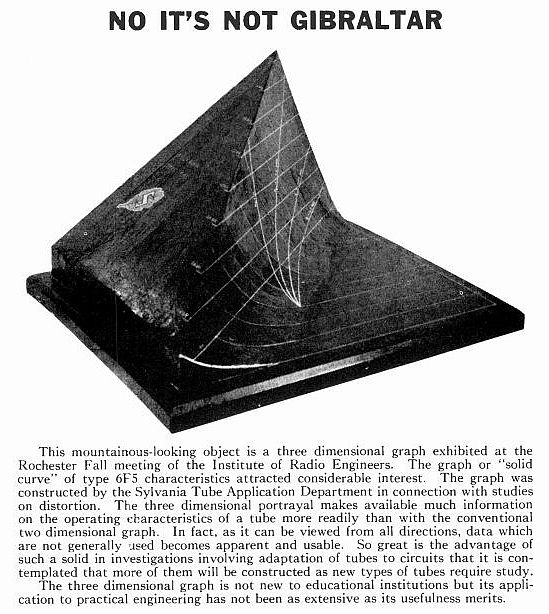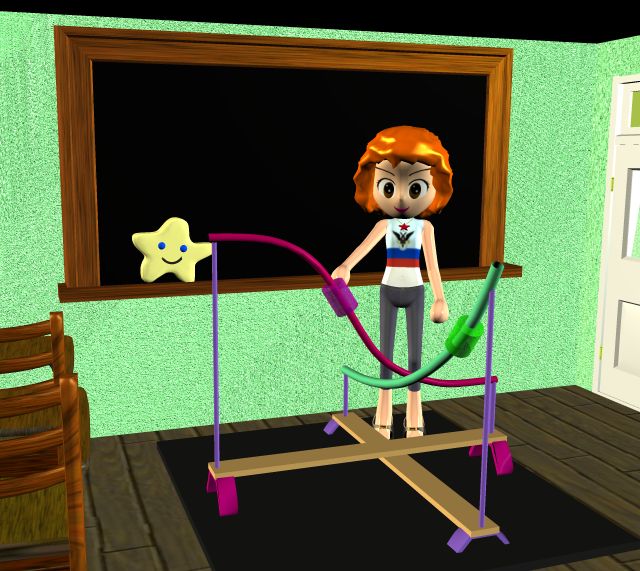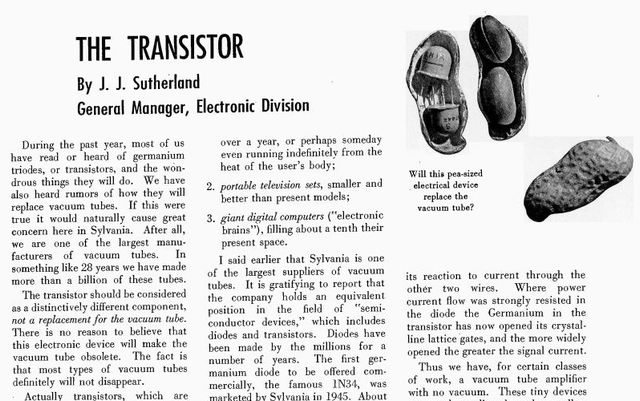Wednesday, December 11, 2019
An idea that didn't get picked up
From an unexpected and obscure source, namely a Sylvania in-house publication in 1936.
 A 4-axis graph of tube characteristics, built in solid touchable plastic.
Why didn't this idea take root and develop? Similar graphs for hard-to-see functions could have been interactive. They could have been built from bent wires with sliding cursors, like giant multidimensional slide rules.
A 4-axis graph of tube characteristics, built in solid touchable plastic.
Why didn't this idea take root and develop? Similar graphs for hard-to-see functions could have been interactive. They could have been built from bent wires with sliding cursors, like giant multidimensional slide rules.
 Specialized circular slide rules came close to the idea sometimes, but they were always strictly flat.
= = = = =
Separately, from a 1953 issue of the same Sylvania publication, their first description of transistors. Sylvania had been first to mass-produce the germanium diode in 1945, so they expected to be among the first in transistors, and they were right.
Specialized circular slide rules came close to the idea sometimes, but they were always strictly flat.
= = = = =
Separately, from a 1953 issue of the same Sylvania publication, their first description of transistors. Sylvania had been first to mass-produce the germanium diode in 1945, so they expected to be among the first in transistors, and they were right.
 The peanut was clever graphics.
Their broader predictions were typical. Underrated in most ways, overrated in one:
The peanut was clever graphics.
Their broader predictions were typical. Underrated in most ways, overrated in one:
 A 4-axis graph of tube characteristics, built in solid touchable plastic.
Why didn't this idea take root and develop? Similar graphs for hard-to-see functions could have been interactive. They could have been built from bent wires with sliding cursors, like giant multidimensional slide rules.
A 4-axis graph of tube characteristics, built in solid touchable plastic.
Why didn't this idea take root and develop? Similar graphs for hard-to-see functions could have been interactive. They could have been built from bent wires with sliding cursors, like giant multidimensional slide rules.
 Specialized circular slide rules came close to the idea sometimes, but they were always strictly flat.
= = = = =
Separately, from a 1953 issue of the same Sylvania publication, their first description of transistors. Sylvania had been first to mass-produce the germanium diode in 1945, so they expected to be among the first in transistors, and they were right.
Specialized circular slide rules came close to the idea sometimes, but they were always strictly flat.
= = = = =
Separately, from a 1953 issue of the same Sylvania publication, their first description of transistors. Sylvania had been first to mass-produce the germanium diode in 1945, so they expected to be among the first in transistors, and they were right.
 The peanut was clever graphics.
Their broader predictions were typical. Underrated in most ways, overrated in one:
The peanut was clever graphics.
Their broader predictions were typical. Underrated in most ways, overrated in one:
The transistor should be considered as a distinctively different component, not a replacement for the vacuum tube. There is no reason to believe that this electronic device will make the vacuum tube obsolete. The fact is that most types of vacuum tubes definitely will not disappear.Pretty accurate up to 1970, but the FET and CMOS broke all of those barriers.
[Transistors could enable] small, vest-pocket and wrist watch radios, almost as good as table models, occupying less volume than present hearing aids and running off one set of batteries fo over a year, or perhaps someday even running indefinitely from the heat of the user's body;Accurate, but the promise of running radios and hearing aids from thermocouples was never fulfilled, and AFAIK never seriously tried. It could be done now with CMOS.
[Transistors could enable] giant digital computers ("electronic brains"), filling about a tenth their present space.Again accurate as of 1970 until FET broke the rules. Now it's more like a millionth, not a tenth.
Labels: Real World Math
